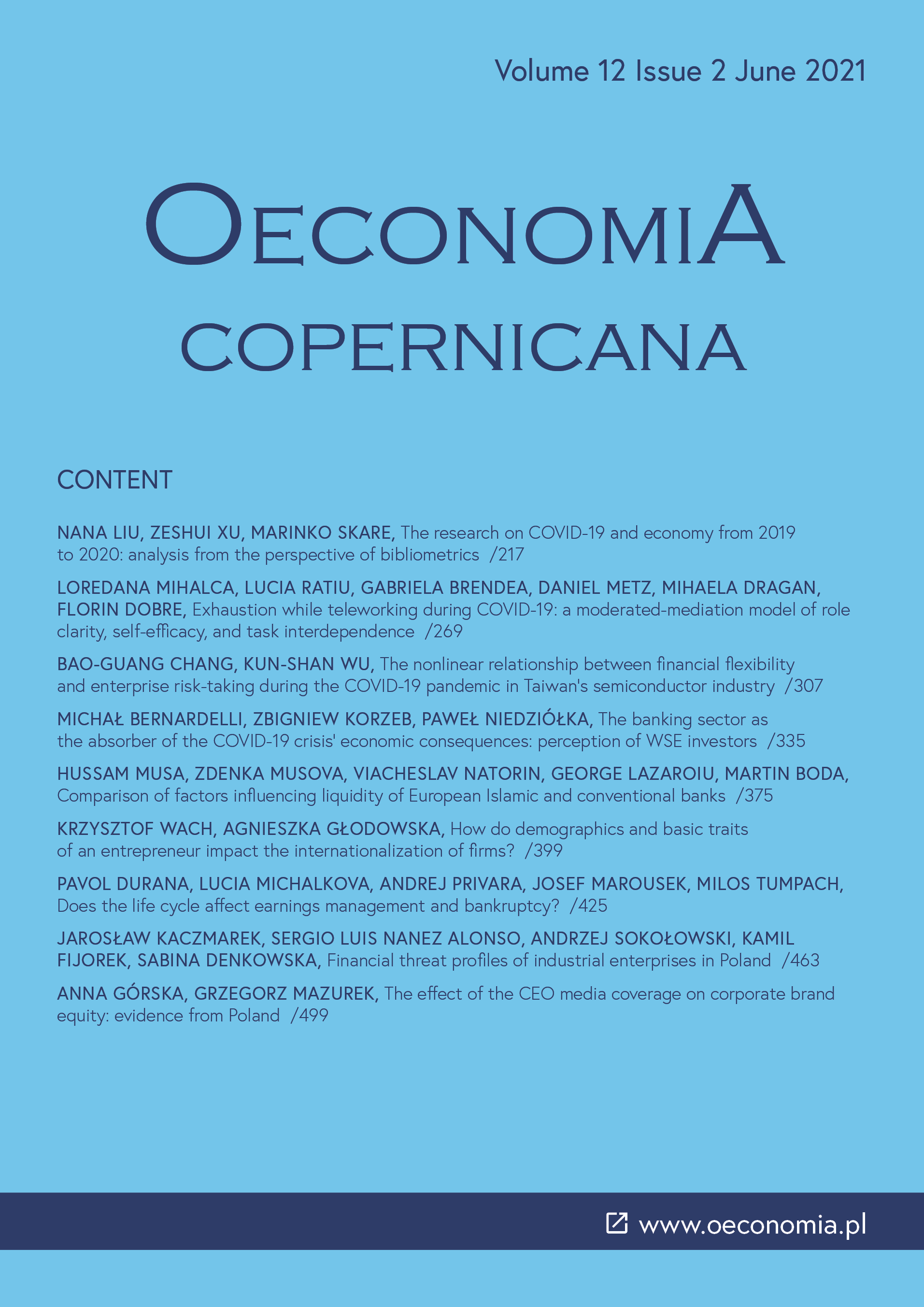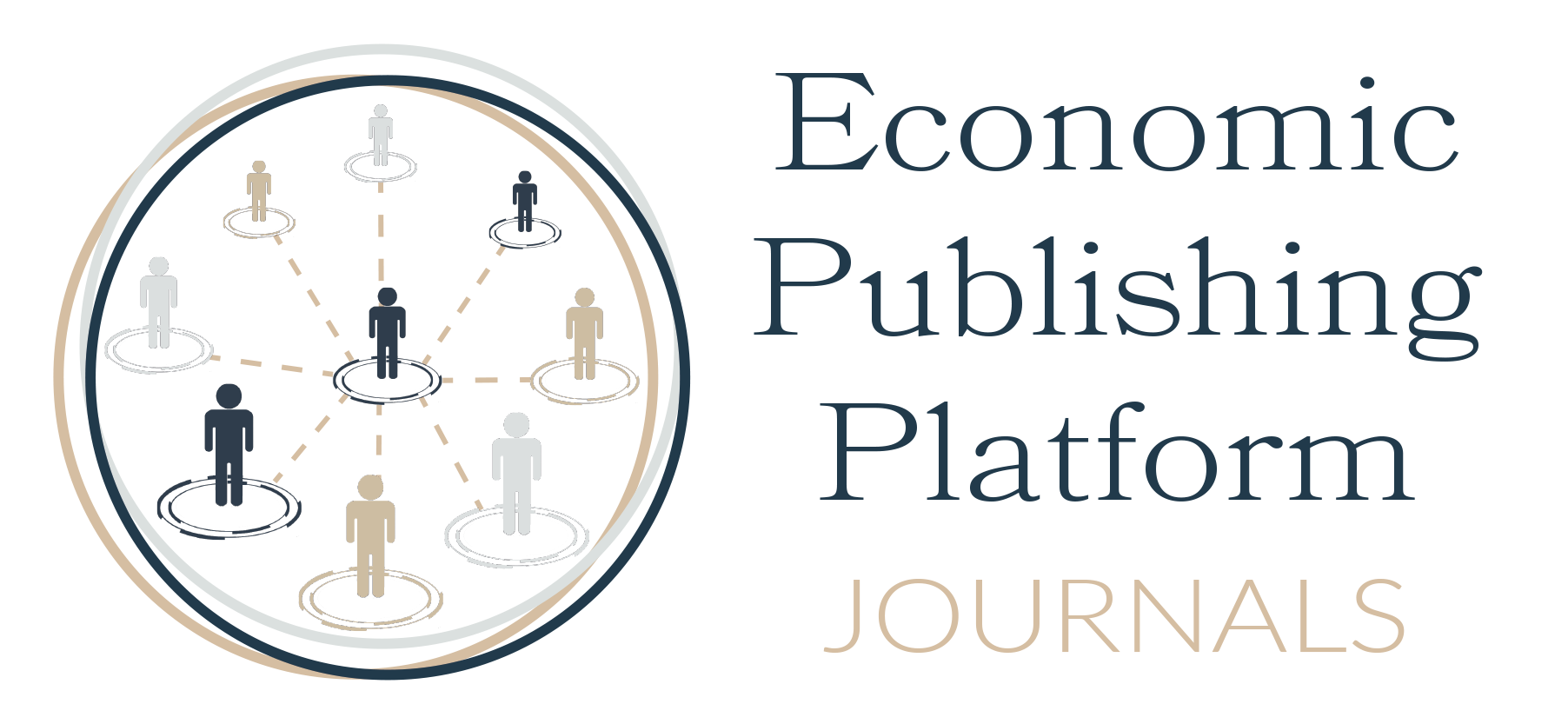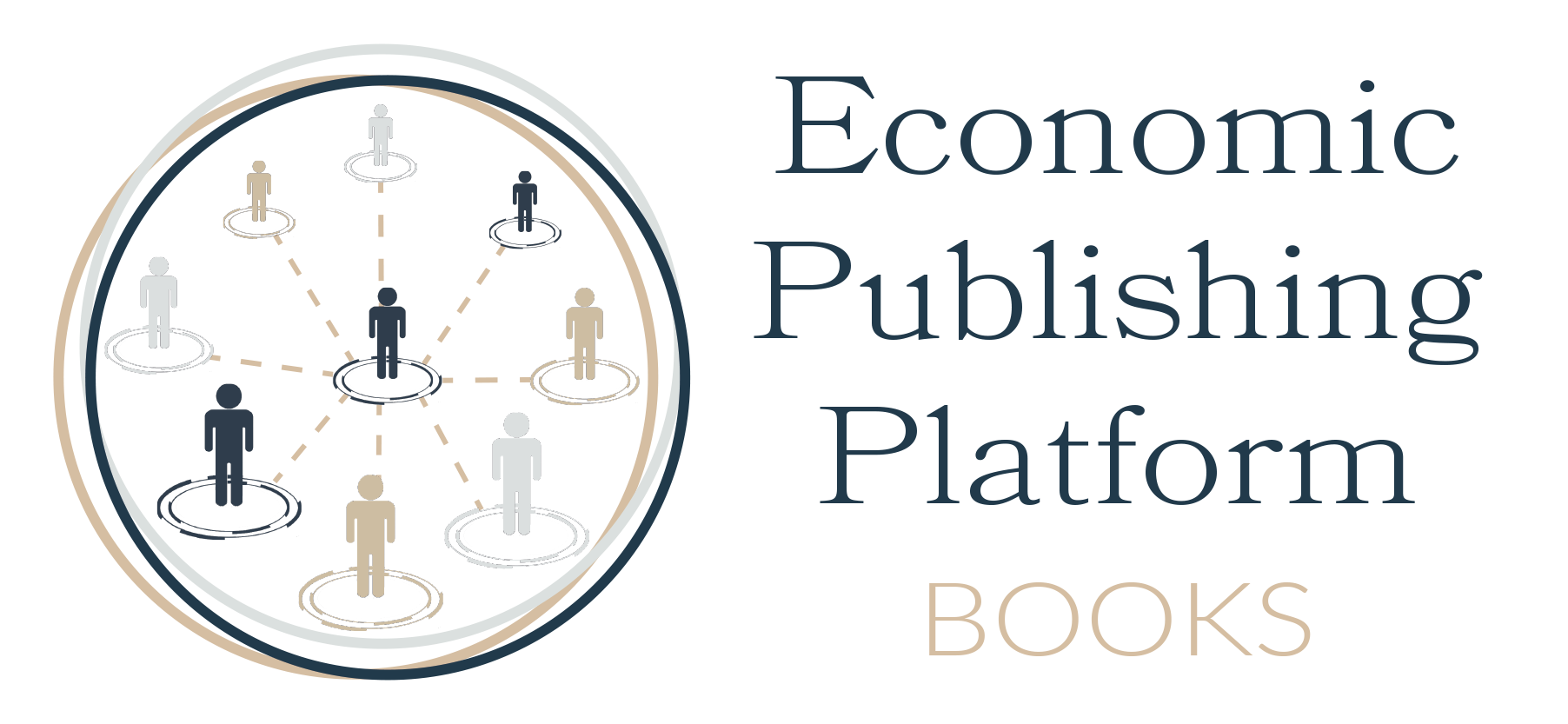Does the life cycle affect earnings management and bankruptcy?
DOI:
https://doi.org/10.24136/oc.2021.015Keywords:
earnings management, corporate life cycle, cash flow pattern, bankruptcyAbstract
Research background: Deteriorating economic conditions and a negative outlook increase the pressure on financial management and the need to show high financial performance. According to Positive Accounting Theory, the growing risk of bankruptcy is associated with the phenomenon of earnings management. Bankruptcy risk and the quality of reported profits, along with other aspects of financial performance, vary throughout the company's life cycle. Nevertheless, these factors or their interactions are investigated only to a very small extent.
Purpose of the article: The aim of this study is to clarify the impact of corporate life cycle and bankruptcy on earnings management, in order to describe behaviour of companies at different stages of corporate life cycle.
Methods: A hierarchical mixed model with a random time and industry effect was chosen as appropriate because it allows the investigation of multilevel data that is not independent. The sample covers the financial indicators of more than 33,000 Central European companies from 2015?2019. The non-sequential Dickinson model, company age, and three models of accrual earnings management were used as proxies for the company's life cycle and quality of reported profit.
Findings & value added: Earnings management and bankruptcy risk have a U-shape, indicating that financially distressed firms reduce reported accounting profit at the Introduction, Decline and, to a lesser extent, at the Growth stage. Slovak and Czech companies manipulate profits to a similar extent, Hungarian companies increase accounting profit to a greatest extent than the surveyed countries by controlling bankruptcy ? life cycle effect; however, the variability of accounting manipulations across industries has not been demonstrated. These findings imply that start-ups and declining businesses provide crooked financial statements to obtain more favourable debt covenants, and estimating discretionary accruals using life-cycle subsamples can improve the predictive power of accrual earnings management models.
Downloads
References
Adizes, I. (1979). Organizational passages-diagnosing and treating lifecycle problems of organizations. Organizational Dynamics, 8(1), 3?25. doi: 10.1016/009 0-2616(79)90001-9.
DOI: https://doi.org/10.1016/0090-2616(79)90001-9
View in Google Scholar
Akbar, A., Akbar, M., Tang, W., & Qureshi, M. A. (2019). Is bankruptcy risk tied to corporate life-cycle? Evidence from Pakistan. Sustainbility, 11(3), 678, doi: 10.3390/su11030678.
DOI: https://doi.org/10.3390/su11030678
View in Google Scholar
Akbar, M., Akbar, A., Maresova, P., Yang, M., & Arshad, H.M. (2020). Unraveling the bankruptcy risk-return paradox across the corporate life cycle. Sustainbility, 12(9), 3547, doi: 10.3390/su12093547.
DOI: https://doi.org/10.3390/su12093547
View in Google Scholar
AlNajjar, F. K., & Riahi-Belkeoui, A. (2001). Empirical validation of a general model of growth opportunities. Managerial Finance, 27(3), 72?90. doi: 10.110 8/03074350110767051.
DOI: https://doi.org/10.1108/03074350110767051
View in Google Scholar
Altman, E (1968). Financial ratios, discriminant analysis and the prediction of corporate bankruptcy. Journal of Finance, 23(4), 589?609. doi: 10.1111/j.15 40-6261.1968.tb00843.x.
DOI: https://doi.org/10.1111/j.1540-6261.1968.tb00843.x
View in Google Scholar
Amin, A., Bowler, B., Hasan, M. M., Lobo, G., & Tresl, J. (2020). Firm life cycle and cost of debt. CERGE-EI Working Paper Series, 665. Retrieved from https://www.cerge-ei.cz/pdf/wp/Wp665.pdf.
DOI: https://doi.org/10.2139/ssrn.3688557
View in Google Scholar
Anthony, J. H., & Ramesh, K. (1992). Association between accounting performance measures and stock prices: a test of the life cycle hypothesis. Journal of Accounting and Economics, 15(2), 203?227. doi: 10.1016/0165-4101(92)90018-W.
DOI: https://doi.org/10.1016/0165-4101(92)90018-W
View in Google Scholar
Beaver, W. H. (1966). Financial ratios as predictors of failure. Journal of Accounting Research, 4, 71?111. doi: 10.2307/2490171.
DOI: https://doi.org/10.2307/2490171
View in Google Scholar
Bender, R., & Ward, K. (2002). Corporate financial strategy. Oxford: Butterworth-Heinemann.
View in Google Scholar
Beneish, M. D. (2001). Earnings management: a perspective. Managerial Finance, 27(12), 3?17. doi: 10.1108/03074350110767411.
DOI: https://doi.org/10.1108/03074350110767411
View in Google Scholar
Blomkvist, M., Loflund, A., & Vyas, H. (2020). Credit ratings and firm life-cycle. Finance Research Letters, 101598. doi: 10.1016/j.frl.2020.101598.
DOI: https://doi.org/10.1016/j.frl.2020.101598
View in Google Scholar
Brzeszczynski, J., Gajda, J., & Schabek, T. (2012). Earnings management in Polish companies. Comparative Economic Research. Central and Eastern Europe, 14(3), 137?150. doi: 10.2478/v10103-011-0023-1.
DOI: https://doi.org/10.2478/v10103-011-0023-1
View in Google Scholar
Burgstahler, D., & Chuk, E. (2017). What have we learned about earnings management? Integrating discontinuity evidence. Contemporary Accounting Research, 34(2), 726?749. doi: 10.1111/1911-3846.12301.
DOI: https://doi.org/10.1111/1911-3846.12301
View in Google Scholar
Bushman, R. M., Smith, A. J., & Zhang, F. (2011). Investment cash flow sensitivities really reflect related investment decisions. Retrieved from https://ssrn.com/abstract=842085.
DOI: https://doi.org/10.2139/ssrn.842085
View in Google Scholar
Cahan, S. B. (1992). The effect of antitrust investigations on discretionary accruals: a refined test of the political ? cost hypothesis. Accounting Review, 67(1), 77?95.
View in Google Scholar
Callao, S., Jarne, J. I., & Wroblewski, D. (2017). Detecting earnings management investigation on different models measuring earnings management for emerging eastern European countries. International Journal of Research ? Granthaalayah, 5(11), 222?259. doi: 10.5281/zenodo.1095448.
DOI: https://doi.org/10.29121/granthaalayah.v5.i11.2017.2351
View in Google Scholar
Campa, D., & Camacho-Minano, M. (2015). The impact of SME?s pre-bankruptcy financial distress on earnings management tools. International Review of Financial Analysis, 42, 222?234. doi: 10.1016/j.irfa.2015.07.004.
DOI: https://doi.org/10.1016/j.irfa.2015.07.004
View in Google Scholar
Can, G. (2020). Do life-cycles affect financial reporting quality? Evidence from emerging market. Cogent Business & Management, 7(1). doi: 10.1080/2331 1975.2020.1854147.
DOI: https://doi.org/10.1080/23311975.2020.1854147
View in Google Scholar
Charitou, A., Lambertides, N., & Trigeorgis, L. (2007). Managerial discretion in distressed firms. British Accounting Review, 39(4), 323?346. doi: 10.1016/j.bar. 2007.08.003.
DOI: https://doi.org/10.1016/j.bar.2007.08.003
View in Google Scholar
Charitou, A., Lambertides, N., & Trigeorgis, L. (2011). Distress risk, growth and earnings quality. Abacus, 47(2), 158?181. doi: 10.1111/j.1467-6281.2011.0 0337.x.
DOI: https://doi.org/10.1111/j.1467-6281.2011.00337.x
View in Google Scholar
Chen, T. (2016). Internal control, life cycle and earnings quality. Open Journal of Business and management, 4(2), 301?311. doi: 10.4236/ojbm.2016.42032.
DOI: https://doi.org/10.4236/ojbm.2016.42032
View in Google Scholar
Chen, X., Cheng, O., Hao, Y., & Liu, O. (2020). GDP growth incentives and earnings management: evidence from China. Review of Accounting Studies, 25, 1002?1039. doi: 10.1007/s11142-020-09547-8.
DOI: https://doi.org/10.1007/s11142-020-09547-8
View in Google Scholar
Chen, X., Yang, W., & Huang, D. (2010). Corporate life cycle and the accrual model: an empirical study based on Chinese listed companies. Frontiers of Business Research in China, 4, 580?607. doi: 10.1007/s11782-010-0112-1.
DOI: https://doi.org/10.1007/s11782-010-0112-1
View in Google Scholar
Cherkasova, V., & Radasi, D. (2017). Earnings quality and investment efficiency: evidence from Eastern Europe. Review of Economic Perspectives, 17(4), 441?468. doi: 10.1515/revecp-2017-0023.
DOI: https://doi.org/10.1515/revecp-2017-0023
View in Google Scholar
Cohen, D. A., & Zarowin, P. (2007). Earnings management over the business cycle. New York University/Stern School of Business. Retrieved from https://citeseerx.ist.psu.edu/viewdoc/download?doi=10.1.1.1060.381&rep=rep1&type=pdf.
View in Google Scholar
Czajor, P., Michalak, J., & Waniak-Michalak, H. (2013). Influence of economy growth on earnings quality of listed companies in Poland. Social Sciences, 82(4), 48?58. doi: 10.5755/j01.ss.82.4.6602.
DOI: https://doi.org/10.5755/j01.ss.82.4.6602
View in Google Scholar
Damodaran, A. (2018). The corporate life cycle: growing up is hard to do! Retrieved from http://people.stern.nyu.edu/adamodar/pdfiles/country/corporat elifecycleLongX.pdf
View in Google Scholar
Dechow, P. (1994). Accounting earnings and cash flows as measures of firm performance: the role of accounting accruals. Journal of Accounting and Economics, 18(1), 3?42. doi: 10.1016/0165-4101(94)90016-7.
DOI: https://doi.org/10.1016/0165-4101(94)90016-7
View in Google Scholar
Dechow, P., Ge, W., & Schrand, C. (2010). Understanding earnings quality: a review of the proxies, their determinants and their consequences. Journal of Accounting and Economics, 50(2-3), 344?401. doi: 10.1016/j.jacceco.2010.0 9.001.
DOI: https://doi.org/10.1016/j.jacceco.2010.09.001
View in Google Scholar
Dechow, P. M., Sloan, R. G., & Sweeney, A. P. (1995). Detecting earnings management. Accounting Review, 70(2), 193?225.
View in Google Scholar
DeFond, M. L., & Jiambalvo, J. (1994). Debt covenant violation and manipulation of accruals. Journal of Accounting and Economics, 17(1-2), 145?176. doi: 10.1016/0165-4101(94)90008-6.
DOI: https://doi.org/10.1016/0165-4101(94)90008-6
View in Google Scholar
Degiannakis, S., Giannopoulos, G., Ibrahim, S., & Rozic, I. (2019). Earnings management to avoid losses and earnings declines in Croatia. International Journal of Computational Economics and Econometrics, 9(3), 219?233. doi: 10.1504/IJCEE.2019.100561.
DOI: https://doi.org/10.1504/IJCEE.2019.100561
View in Google Scholar
Delcoure, N. (2007). The determinants of capital structure in transitional economies. International Review of Economics and Finance, 16, 400?415. doi: 10.1016/j.iref.2005.03.005.
DOI: https://doi.org/10.1016/j.iref.2005.03.005
View in Google Scholar
Dickinson, V. (2011). Cash flow patterns as a proxy for firm life cycle. Accounting Review, 86(6), 1969?1994. doi: 10.2308/accr-10130.
DOI: https://doi.org/10.2308/accr-10130
View in Google Scholar
Dickinson, V., Kassa, H., & Schaberl, P.D. (2018). What information matters to investors at different stages of a firm?s life cycle? Advances in Accounting, 42, 22?33. doi: 10.1016/j.adiac.2018.07.002.
DOI: https://doi.org/10.1016/j.adiac.2018.07.002
View in Google Scholar
Drake, K. D. (2015). Does firm life cycle inform the relation between book-tax differences and earnings persistence? Retrieved from https://papers.ssrn. com/sol3/papers.cfm?abstract_id=2547778.
DOI: https://doi.org/10.2139/ssrn.2547778
View in Google Scholar
Dutzi, A., & Rausch, B. (2016). Earnings management before bankruptcy: a review of the literature. Journal of Accounting and Auditing: Research & Practice, 16, doi: 10.5171/2016.245891.
DOI: https://doi.org/10.5171/2016.245891
View in Google Scholar
Euler Hermes (2020a). Calm before the storm: covid-19 and the business insolv ency time bomb. Retrieved from https://www.eulerhermes.com/content/ dam/onemarketing/ehndbx/eulerhermes_com/en_gl/erd/publications/pdf/Final-2020_07_16_InsolvencyTimeBomb.pdf
View in Google Scholar
Euler Hermes (2020b). Europe: One in four corporates will need more policy support in 2021 to avert a cash-flow crisis. Retrieved from https://www.eulerh ermes.com/en_global/news-insights/economic-insights/Europe-One-in-four-cor porates-will-need-more-policy-support-in-2021-to-avert-a-cash-flow-crisis.html
View in Google Scholar
Faff, R., Kwok, W. C., Podolski, E. J., & Wong, G. (2016). Do corporate policies follow a life-cycle? Journal of Banking & Finance, 69, 95?107. doi: 10.1016/ j.jbankfin.2016.04.009.
DOI: https://doi.org/10.1016/j.jbankfin.2016.04.009
View in Google Scholar
Fialova, V., & Folvarcna, A. (2020). Default prediction using neural networks for enterprises from the post-soviet country. Ekonomicko-manazerske spektrum, 14(1), 43?51. doi: 10.26552/ems.2020.1.43-51.
DOI: https://doi.org/10.26552/ems.2020.1.43-51
View in Google Scholar
FitchRatings (2020). Global economic outlook - December 2020. Retrieved from https://www.fitchratings.com/research/sovereigns/global-economic-outlook-dec ember-2020-07-12-2020.
View in Google Scholar
Garcia Lara, J. M., Garcia Osma, B., & Neophytou, E. (2009). Earnings quality in ex?post failed firms. Accounting and Business Research, 39(2), 119?138. doi: 10.1080/00014788.2009.9663353.
DOI: https://doi.org/10.1080/00014788.2009.9663353
View in Google Scholar
Garcia-Teruel, P. J., Martinez-Solano, P., & Sanchez-Ballesta, J. P. (2014). Supplier financing and earnings quality. Journal of Business Finance & Accounting, 41(9) & (10), 1193?1211. doi: 10.1111/jbfa.12090.
DOI: https://doi.org/10.1111/jbfa.12090
View in Google Scholar
Gaver, J. J., & Gaver, K. M. (1993). Additional evidence on the association between the investment opportunity set and corporate financing, dividend, and compensation policies. Journal of Accounting and Economics, 16(1-3), 125?160. doi: 10.1016/0165-4101(93)90007-3.
DOI: https://doi.org/10.1016/0165-4101(93)90007-3
View in Google Scholar
Gelman, A. (2006). Multilevel (hierarchical) modeling: what it can and cannot do. Technometrics, 48(3), 432?435. doi: 10.1198/004017005000000661.
DOI: https://doi.org/10.1198/004017005000000661
View in Google Scholar
Gourinchas, P. O., Kalemli-Ozcan, B., Peciakova, V., & Sander, N. (2020). COVID-19 and SME failures. NBER Working Paper Series, 27877. doi: 10.338 6/w27877.
DOI: https://doi.org/10.5089/9781513557748.001
View in Google Scholar
Graham, J. R., Harvey, C. R., & Rajgopal, S. (2005). The economic implications of corporate financial reporting. Journal of Accounting and Economics, 40(1-3), 3?73. doi: 10.1016/j.jacceco.2005.01.002.
DOI: https://doi.org/10.1016/j.jacceco.2005.01.002
View in Google Scholar
Gregova, E., Smrcka, L., Michalkova, L., & Svabova, L. (2021). Impact of tax benefits and earnings management on the capital structure across V4 countries. Acta Polytechnica Hungarica. 18(3), 221?244. doi: 10.12700/APH.18.3.2021 .3.12.
DOI: https://doi.org/10.12700/APH.18.3.2021.3.12
View in Google Scholar
Grice, J. S, & Dugan, M. T. (2003). Re-estimations of the Zmijewski and Ohlson bankruptcy prediction models. Advances in Accounting, 20, 77?93. doi: 10.101 6/S0882-6110(03)20004-3.
DOI: https://doi.org/10.1016/S0882-6110(03)20004-3
View in Google Scholar
Grofcikova, J. (2020). Impact of selected determinants of corporate governance on financial performance of companies. Ekonomicko-manazerske spektrum, 14(2), 12?23. doi: 10.26552.ems.2020.12-23.
DOI: https://doi.org/10.26552/ems.2020.2.12-23
View in Google Scholar
Gu, Z., Lee, C. W. J., & Rosett, J. G (2005). What determines the variability of accounting accruals? Review of Quantitative Finance and Accounting, 24, 313?334. doi: 10.1007/s11156-005-6869-1.
DOI: https://doi.org/10.1007/s11156-005-6869-1
View in Google Scholar
Gujarati, D. N., & Porter, D. C. (2008). Basic econometrics. New York: McGraw-Hill Education.
View in Google Scholar
Gulec, O. F., & Karacaer, S. (2017). Corporate life cycle methods in emerging markets: evidence from Turkey. Journal of Economics, Finance & Accounting, 4(3), 224?236. doi: 10.17261/Pressacademia.2017.690.
DOI: https://doi.org/10.17261/Pressacademia.2017.690
View in Google Scholar
Habib, A., & Hasan, M. M. (2017). Firm life cycle, corporate risk?taking and investor sentiment. Accounting & Finance, 57(2), 456?497. doi: 10.1111/acfi. 12141.
DOI: https://doi.org/10.1111/acfi.12141
View in Google Scholar
Hastuti, T. D., Ghozali, I., & Yuyetta, E. N. A. (2017). The effect of company life cycles on the accruals earnings management with internal control system as moderating variable. Polish Journal of Management Studies, 15(1), 66?75. doi: 10.17512/pjms.2017.15.1.07.
DOI: https://doi.org/10.17512/pjms.2017.15.1.07
View in Google Scholar
Hayn, C. (1995). The information content of losses. Journal of Accounting and Economics, 20(2), 125?153. doi: 0.1016/0165-4101(95)00397-2.
DOI: https://doi.org/10.1016/0165-4101(95)00397-2
View in Google Scholar
Hoglund, H. (2012). Detecting earnings management with neural networks. Expert Systems with Applications, 39(10), 9564?9570. doi: 10.1016/j.eswa.2012.02 .096
DOI: https://doi.org/10.1016/j.eswa.2012.02.096
View in Google Scholar
Homola, D., & Pasekova, M. (2020). Factors influencing true and fair view when preparing financial statements under IFRS: evidence from the Czech Republic. Equilibrium. Quarterly Journal of Economics and Economic Policy, 15(3). doi: 10.24136/eq.2020.026.
DOI: https://doi.org/10.24136/eq.2020.026
View in Google Scholar
Hribar, P., & Yehuda, N. (2015). The mispricing of cash flows and accruals at different life?cycle stages. Contemporary Accounting Research, 32(3), 1053?1072. doi: 10.1111/1911-3846.12117.
DOI: https://doi.org/10.1111/1911-3846.12117
View in Google Scholar
Hussain, A., Akbar, M., Khan, M. K., Akbar, A., Panait, M., & Voica, M. C. (2020). When does earnings management matter? Evidence across the corporate life cycle for non-financial Chinese listed companies. Journal of Risk and Financial Management, 13(12), 313. doi: 10.3390/jrfm13120313.
DOI: https://doi.org/10.3390/jrfm13120313
View in Google Scholar
Iatridis, G. (2010). International financial reporting standards and the quality of financial statement information. International Review of Financial Analysis, 43, 193?204. doi: 10.1016/j.irfa.2010.02.004.
DOI: https://doi.org/10.1016/j.irfa.2010.02.004
View in Google Scholar
Iatridis, G., & Kadorinis, G. (2009). Earnings management and firm financial motives: a financial investigation of UK listed firms. International Review of Financial Analysis, 18(4), 164?173. doi: 10.1016/j.irfa.2009.06.001.
DOI: https://doi.org/10.1016/j.irfa.2009.06.001
View in Google Scholar
Istrate, C., Georgescu, I. E., Carp, M., Robu, I. B., & Pavaloaia, L. (2015). Accruals earnings management in emerging markets under the transition to IFRS: the case of Romanian listed companies. Transformations in Business & Economics, 14(2A), 393?411.
View in Google Scholar
Jaggi, B., & Lee, P. (2002). Earnings management response to debt covenant violations and debt restructuring. Journal of Accounting, Auditing & Finance, 17(4), 295?324. doi: 10.1177/0148558X0201700402.
DOI: https://doi.org/10.1177/0148558X0201700402
View in Google Scholar
Jardin, P., Veganzones, D., & Severin, E. (2019). Forecasting corporate bankruptcy using accrual-based models. Computational Economics, 54, 7?43. doi: 10.1007 /s10614-017-9681-9.
View in Google Scholar
Jones, J. (1991). Earnings management during import relief investigations. Journal of Accounting Research, 29(2), 193?228. doi: 10.2307/2491047.
DOI: https://doi.org/10.2307/2491047
View in Google Scholar
Joosten C. (2012). Real earnings management and accrual-based earnings management as substitutes (Master thesis, Tilburg university). Retrieved from https://arno.uvt.nl/show.cgi?fid=127248.
View in Google Scholar
Jovanovic, B. (1982). Selection and the evolution of industry. Econometrica, 50(3), 649?670.
DOI: https://doi.org/10.2307/1912606
View in Google Scholar
Kasznik, R. (1999). On the association between voluntary disclosure and earnings management. Journal of Accounting Research, 37(1), 57?81. doi: 10.2307/249 1396.
DOI: https://doi.org/10.2307/2491396
View in Google Scholar
Kayo, E. K., & Kimura, H. (2010). Hierarchical determinants of capital structure. Journal of Banking & Finance, 35(2), 358?371. doi: 10.1016/j.jbankfin.2010.0 8.015.
DOI: https://doi.org/10.1016/j.jbankfin.2010.08.015
View in Google Scholar
Kliestik, T., Belas, J., Valaskova, K., Nica, E., & Durana, P. (2020a). Earnings management in V4 countries: the evidence of earnings smoothing and inflating, Economic Research-Ekonomska Istraživanja, doi: 10.1080/1331677X.2020. 1831944.
DOI: https://doi.org/10.1080/1331677X.2020.1831944
View in Google Scholar
Kliestik, T., Valaskova, K., Nica, E., Kovacova, M., & Lazaroiu, G. (2020b). Advanced methods of earnings management: monotonic trends and change-points under spotlight in the Visegrad countries. Oeconomia Copernicana, 11(2), 371?400. doi: 10.24136/oc.2020.016.
DOI: https://doi.org/10.24136/oc.2020.016
View in Google Scholar
Kothari, S. P., Leone, A. J., & Wasley, C. E. (2005). Performance matched discretionary accrual measures. Journal of Accounting and Economics, 39(1), 163?197. doi: 10.1016/j.jacceco.2004.11.002.
DOI: https://doi.org/10.1016/j.jacceco.2004.11.002
View in Google Scholar
Kramarova, K. (2021). Transfer pricing and controlled transactions in connection with earnings management and tax avoidance. SHS Web of Conferences, 92, 02031. doi: 10.1051/shsconf/20219202031.
DOI: https://doi.org/10.1051/shsconf/20219202031
View in Google Scholar
Kramarova, K., & Valaskova, K. (2020). Application of chosen fraudulent detection technique in the Slovak business environment. SHS Web of Conferences, 74, 01019. doi: 10.1051/shsconf/20207401019.
DOI: https://doi.org/10.1051/shsconf/20207401019
View in Google Scholar
Leach, R., & Newsom, P. (2007). Do firms manage their earnings prior to filing for bankruptcy? Academy of Accounting and Financial Studies Journal, 11(3), 125?137.
View in Google Scholar
Leuz, C., Nanda, D., & Wysocki, P. D. (2003). Earnings management and investor protection: an international comparison. Journal of Financial Economics, 69(3). doi: 10.1016/S0304-405X(03)00121-1.
DOI: https://doi.org/10.1016/S0304-405X(03)00121-1
View in Google Scholar
Lisboa, I., & Kacharava, A. (2018). Does financial crisis impact earnings management: evidence from Portuguese and UK. European Journal of Applied Business Management, 4(1), 80?100.
View in Google Scholar
Liu, M. (2006). Accruals and managerial operating decisions over the firm life cycle. Doctoral dissertation, Massachusetts Institute of Technology. Retrieved from http://oastats.mit.edu/bitstream/handle/1721.1/37251/85835990-MIT.pdf? sequence=2&isAllowed=y.
View in Google Scholar
Lizinska, J., & Czapiewski, L. (2018). Towards economic corporate sustainability in reporting: what does earnings management around equity offerings mean for long-term performance? Sustainbility, 10(12), 4349. doi: 10.3390/su10124349.
DOI: https://doi.org/10.3390/su10124349
View in Google Scholar
Mangoting, Y., & Onggara, C. T. (2018). The firm life cycle dynamics of tax avoidance. Advances in Economics, Business and Management Research, 69, 198?204. doi: 10.2991/teams-18.2019.35.
DOI: https://doi.org/10.2991/teams-18.2019.35
View in Google Scholar
Marinsek, D. (2017). Multilevel regression and cluster confounding in finance: study of corporate capital structure. Ljubljana: Faculty of Economics, University of Ljubljana.
View in Google Scholar
Matonti, G., Tommasetti, A., Torre, C., & Tucker, J. (2020). The impact of financial difficulties on earnings management strategies: the case of Italina non-listed firms. African Journal of Business Management, 14(11), 511?528. doi: 10.5897/AJBM2020.9105.
DOI: https://doi.org/10.5897/AJBM2020.9105
View in Google Scholar
Matsumoto, D. A. (2002). Management's incentives to avoid negative earnings surprises. Accounting Review, 77(3), 483?514.
DOI: https://doi.org/10.2308/accr.2002.77.3.483
View in Google Scholar
McKee, T. E. (2005). Earnings management: an executive perspective. Indiana: Thomson.
View in Google Scholar
Michalkova, L. (2021). Earnings quality and accruals over company´s life cycle. SHS Web of Conferences, 92, 02043. doi: 10.1051/shsconf/20219202043.
DOI: https://doi.org/10.1051/shsconf/20219202043
View in Google Scholar
Miller, D., & Friesen, P. H. (1984). A longitudinal study of the corporate life cycle. Management Science, 30(10), 1161?1183. doi: 10.1287/mnsc.30.10.1161.
DOI: https://doi.org/10.1287/mnsc.30.10.1161
View in Google Scholar
Moores, K., & Yuen, S. (2001). Management accounting systems and organizational configuration: a life-cycle perspective. Accounting, Organizations and Society, 26(4-5), 351?389, doi: 10.1016/S0361-3682(00)00040-4.
DOI: https://doi.org/10.1016/S0361-3682(00)00040-4
View in Google Scholar
OECD (2020). OECD economic outlook, Volume 2020 Issue 2, Paris: OECD Publishing. doi: 10.1787/39a88ab1-en.
DOI: https://doi.org/10.1787/39a88ab1-en
View in Google Scholar
Oshchepkov, A., & Shirokanova, A. (2020). Multilevel modeling for economists: why, when and how. Higher School of Economics Research Paper. Moscow. National Research University Higher School of Economics, WP BRP 233/EC/2020.
DOI: https://doi.org/10.2139/ssrn.3637907
View in Google Scholar
Pachariyanon, P. (2014). The relationship between company life-cycle and the choice of earnings management. Dissertation Thesis. Retrieved from https://core.ac.uk/download/pdf/145779435.pdf
View in Google Scholar
Papadaki, A., & Tzovas, C. (2017). Financial crisis and accrual and real earnings management in Europe. Corporate Ownership & Control, 14(3), 8?19. doi: 10.22495/cocv14i3art1.
DOI: https://doi.org/10.22495/cocv14i3art1
View in Google Scholar
Papik, M., & Papikova, L. (2020). Detection models for unintentional financial restatements. Journal of Business Economics and Management, 21(1). 64?86. doi: 10.3846/jbem.2019.10179.
DOI: https://doi.org/10.3846/jbem.2019.10179
View in Google Scholar
Papík, M., & Papíková, L. (2021). Application of selected data mining techniques in unintentional accounting error detection. Equilibrium. Quarterly Journal of Economics and Economic Policy, 16(1), 185?201. doi: 10.24136/eq.2021.007.
DOI: https://doi.org/10.24136/eq.2021.007
View in Google Scholar
Park, Y., & Chen, K. (2006). The effect of accounting conservatism and life-cycle stages on firm valuation. Journal of Applied Business Research, 22(3), 75?92. doi: 10.19030/jabr.v22i3.1428.
DOI: https://doi.org/10.19030/jabr.v22i3.1428
View in Google Scholar
Paulo, E., & Gurgel Mota, R. H. (2019). Business cycles and earnings management strategies: a study in Brazilian public firms. Revista Contabilidade & Financas, 30(80), 216?233. doi: 10.1590/1808-057x201806870.
DOI: https://doi.org/10.1590/1808-057x201806870
View in Google Scholar
Petersen, M. A. (2009). Estimating standard errors in finance panel data sets: comparing approaches. Review of Financial Studies, 22(1), 435?480. doi: 10.1093/rfs/hhn053.
DOI: https://doi.org/10.1093/rfs/hhn053
View in Google Scholar
Ronen, J., & Yaari, V. (2008). Earnings management. Emerging insight in theory, practice, and research. New York: Springer.
View in Google Scholar
Rusmin, R. (2010). Auditor quality and earnings management: Singaporean evidence. Managerial Auditing Journal, 25(7), 618?638. doi: 10.1108/02686 901011061324.
DOI: https://doi.org/10.1108/02686901011061324
View in Google Scholar
Scott, W. R. (1997). Financial accounting theory. Scarborough: Prentice Hall.
View in Google Scholar
Seifert, B., & Gonenc, H. (2012). Creditor rights and R&D expenditures. Corporate Governance: An International Review, 20(1), 3?20. doi: 10.1111/j.1 467-8683.2011.00881.x.
DOI: https://doi.org/10.1111/j.1467-8683.2011.00881.x
View in Google Scholar
Smith, M., Kestel, J., & Robinson, P. (2001). Economic recession, corporate distress and income increasing accounting policy choice. Accounting Forum, 25(4), 334?352. doi: 10.1111/1467-6303.00070.
DOI: https://doi.org/10.1111/1467-6303.00070
View in Google Scholar
Snijders, T. A., & Bosker, R. J. (2012). Multilevel analysis: an introduction to basic and advanced multilevel modeling. London etc.: Sage Publishers
View in Google Scholar
Sosnowski, T. (2017). Earnings management and the floatation structure: empirical evidence from Polish IPOs. Equilibrium. Quarterly journal of Economics and Economic Policy, 12(4), 693?709. doi: 10.24136/eq.v12i4.36.
DOI: https://doi.org/10.24136/eq.v12i4.36
View in Google Scholar
Sosnowski, T. (2018). Earnings management in the private equity divestment process on Warsaw Stock Exchange. Equilibrium. Quarterly Journal of Economics and Economic Policy, 13(4), 689?705. 10.24136/eq.2018.033.
DOI: https://doi.org/10.24136/eq.2018.033
View in Google Scholar
Strakova, l. (2020). Earnings management in global background. SHS Wweb of Conferences, 74, 01032. doi: 10.1051/shsconf/20207401032.
DOI: https://doi.org/10.1051/shsconf/20207401032
View in Google Scholar
Suberi, A. Z. M., Hsu, G., & Wyatt, A. (2012). The relation between firm growth and accounting quality: a test of the life cycle hypothesis. Brisbane: University of Queensland, Australia.
View in Google Scholar
Svabova, L., Svabova, K., Chutka, J., & Strakova, L. (2020). Detecting earnings manipulation and fraudulent financial reporting in Slovakia. Oeconomia Copernicana, 11(3), 485?508. doi:10.24136/oc.2020.020.
DOI: https://doi.org/10.24136/oc.2020.020
View in Google Scholar
Teoh, S., Welch, I., & Wong, T. (1998). Earnings management and the underperformance of seasoned equity offerings. Journal of Financial Economics, 50(1), 63?99. doi: 10.1016/S0304-405X(98)00032-4.
DOI: https://doi.org/10.1016/S0304-405X(98)00032-4
View in Google Scholar
Tian, L., Han, L., & Zhang, S. (2015). Business life cycle and capital structure: evidence from Chinese manufacturing firms. China & World Economy, 23(2), 22?39. doi: 10.1111/cwe.12105.
DOI: https://doi.org/10.1111/cwe.12105
View in Google Scholar
United Nations (2021). World economic situation and prospects 2021. Retrieved from https://www.un.org/development/desa/dpad/wp-content/uploads/sites/45 /WESP2021_FullReport.pdf
View in Google Scholar
Valaskova, K., & Durana, P. (2020). Global context of disparities in earnings management among enterprises: evidence from Slovakia. SHS Web of Conferences, 74, 010034. doi: 10.1051/shsconf/20207401034.
DOI: https://doi.org/10.1051/shsconf/20207401034
View in Google Scholar
Wang, Z., Akbar, M., & Akbar, A. (2020). The interplay between working capital management and a firm?s financial performance across the corporate life cycle. Sustainability, 12(4), 1661. doi: 10.3390/su12041661.
DOI: https://doi.org/10.3390/su12041661
View in Google Scholar
Watts, R. L., & Zimmerman, J. L. (1990). Positive accounting theory: a ten year perspective. Accounting Review, 65(1), 131?156.
View in Google Scholar
Wernerfelt, B. (1985). The dynamics of prices and market shares over the product life cycle. Management Science, 31(8), 928?939. doi: 10.1287/mnsc.31.8.928.
DOI: https://doi.org/10.1287/mnsc.31.8.928
View in Google Scholar
World Bank (2021). Global economic prospects, January 2021. Washington, DC: World Bank. doi: 10.1596/978-1-4648-1612-3.
DOI: https://doi.org/10.1596/978-1-4648-1612-3
View in Google Scholar
Zadband, V. K., & Omrani, H. (2014). The effect of corporate life cycle on financial reporting quality companies listed in Tehran stock exchange. International Journal of Management & Information Technology, 9(2), 1564?1571. doi: 10.24297/ijmit.v9i2.666.
DOI: https://doi.org/10.24297/ijmit.v9i2.666
View in Google Scholar
Downloads
Published
How to Cite
Issue
Section
License
Copyright (c) 2021 Oeconomia Copernicana

This work is licensed under a Creative Commons Attribution 4.0 International License.






